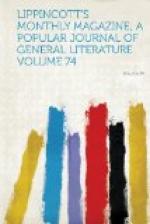As the Hamlet of Rossi is unmistakably mad, so his Macbeth is an undeniable craven and criminal. I can compare this personation to nothing so much as to that of a man haunted by a fiend. For the steps of Macbeth are dogged ever by an unseen devil—namely, his own evil yet coward nature. He is wicked and he is afraid. The whole physique of Rossi in the scene in the first act where the king heaps favors and commendations on his valiant warrior was eloquent of conscious guilt: the constrained attitude, the shifting, uneasy glance, told, louder than words, of a wicked purpose and a stinging conscience. From the moment of the murder the wretched thane lives in a perpetual atmosphere of fear. He is afraid of everything—first of his own unwashed hands, and next of the dead king; then of Banquo and of Banquo’s ghost; and finally he is afraid of all the world. It is only at the last that the mere physical courage of the soldier reasserts itself, and Macbeth, driven to bay by Fate, fights with the fierce energy of despair.
As to Rossi’s Lear, it is not to be criticised. Words fail when the heartstrings are thrilled to trembling and to tears. The pathos of Lear’s recognition of Cordelia was past the power of words to describe. He stands at first gazing in vague bewilderment at the face of his child, then into the darkened and troubled gaze steals anew the light of reason and of recognition: unutterable sorrow, inexpressible remorse, sweep across the quivering features, and with an inarticulate sob Lear would fain sink on his knees at his wronged daughter’s feet to pray for pardon. That people rose and left the house in a very passion of tears is the fittest criticism that can be bestowed upon this personation.
The list of the Shakesperian characters closed with Romeo. Rossi was the divinest of lovers, in spite of his forty years and his stalwart proportions, and the balcony scene was an exquisite love-duet that needed not the aid of music to lend it sweetness. But in the Italian version the play was so cut and garbled that there could be little pleasure in listening to it for any one familiar with the original.
Outside of his Shakespearian repertoire, Rossi has appeared in only two plays—the Kean of the elder Dumas, and Nero, a tragedy by Signer Cosso, The first, originally written for Lemaitre, is an ill-constructed, improbable melodrama. But it contains one grand scene—namely, that where Kean, whilst playing Hamlet, goes mad upon the stage; and this scene Rossi renders superbly. As to Nero, it is marvelous to witness the complete eclipse of the refined, accomplished gentleman and intellectual actor behind the brutal physiognomy of the wicked emperor. It is Hamlet transformed into a prize-fighter.




